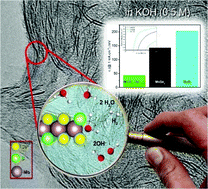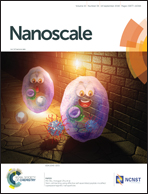Enhancing the catalytic activity of the alkaline hydrogen evolution reaction by tuning the S/Se ratio in the Mo(SxSe1−x)2 catalyst†
Abstract
The alkaline hydrogen evolution reaction (HER) plays a key role in photo(electro)catalytic water splitting technologies, particularly in water–alkali electrolyzers. Unfortunately, although transition metal dichalcogenide (TMD) materials, especially MoS2 and MoSe2, are considered efficient, Earth-abundant catalysts for the HER in an acidic electrolyte, they are much less effective under high pH conditions due to a sluggish water dissociation process (Volmer-step) and strong adsorption of the OH− intermediate on their surfaces. Herein we show a novel synergetic effect obtained by tailoring the S/Se ratio in Mo(SxSe1−x)2 alloys. We were able to influence the metal oxidation state and d-band to optimize the catalytic sites for H⋯OH dissociation and OH− desorption while maintaining favourable M–H energetics. The Mo(SxSe1−x)2 (x = 0.58) catalyst exhibited high performance with an onset potential of −43 mV in 0.5 M KOH, i.e., ∼3 and ∼4-fold less than that for MoSe2 and MoS2, respectively. The results obtained in the current study have implications for the rational design of cost-effective electro-catalysts for water reduction based on TMD alloys.



 Please wait while we load your content...
Please wait while we load your content...